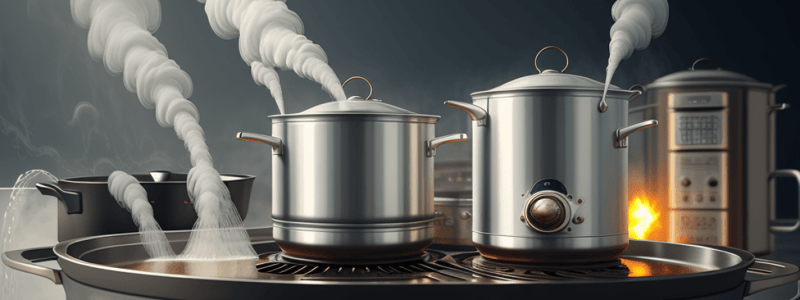Podcast
Questions and Answers
What is the reverse of boiling?
What is the reverse of boiling?
- Evaporation
- Condensation (correct)
- Melting
- Freezing
What are the two main types of boiling?
What are the two main types of boiling?
- Evaporation and condensation
- Sublimation and deposition
- Freezing and melting
- Nucleate boiling and critical heat flux boiling (correct)
What is the boiling point of water?
What is the boiling point of water?
- 75°C or 167°F
- 50°C or 122°F
- 125°C or 257°F
- 100°C or 212°F (correct)
What is the purpose of boiling water?
What is the purpose of boiling water?
What is the method of cooking food in boiling water or other water-based liquids called?
What is the method of cooking food in boiling water or other water-based liquids called?
What is simmering?
What is simmering?
What is the characteristic attribute of an element at a given pressure?
What is the characteristic attribute of an element at a given pressure?
What is the constant boiling mixture?
What is the constant boiling mixture?
What is evaporation?
What is evaporation?
Flashcards
What is condensation?
What is condensation?
The process where a gas or vapor changes into a liquid, the opposite of boiling.
Types of boiling?
Types of boiling?
Nucleate boiling involves bubble formation on a heated surface, while critical heat flux boiling occurs when the heat transfer reaches a maximum and can lead to a rapid temperature increase.
Water's boiling point?
Water's boiling point?
The temperature at which water transitions from a liquid to a gas at standard atmospheric pressure.
Why boil water?
Why boil water?
Signup and view all the flashcards
What is boiling (cooking)?
What is boiling (cooking)?
Signup and view all the flashcards
What is simmering?
What is simmering?
Signup and view all the flashcards
What is boiling point?
What is boiling point?
Signup and view all the flashcards
Constant boiling mixture?
Constant boiling mixture?
Signup and view all the flashcards
What is evaporation?
What is evaporation?
Signup and view all the flashcards
Study Notes
Boiling is the rapid phase transition from liquid to gas or vapor, and the reverse of boiling is condensation. The two main types of boiling are nucleate boiling, where small bubbles of vapor form at discrete points, and critical heat flux boiling, where the boiling surface is heated above a certain critical temperature and a film of vapor forms on the surface. The boiling point of water is 100 °C or 212 °F but is lower with the decreased atmospheric pressure found at higher altitudes. Boiling water is used as a method of making it potable by killing microbes and viruses that may be present. Boiling water is also used in several cooking methods including boiling, steaming, and poaching. The boiling point of an element at a given pressure is a characteristic attribute of the element. Mixtures of volatile liquids have a boiling point specific to that mixture producing vapor with a constant mix of components - the constant boiling mixture. Most types of refrigeration and some type of air-conditioning work by compressing a gas so that it becomes liquid and then allowing it to boil. Boiling is the method of cooking food in boiling water or other water-based liquids such as stock or milk. Simmering is gentle boiling, while in poaching, the cooking liquid moves but scarcely bubbles. At any given temperature, the molecules in a liquid have varying kinetic energies. Some high energy particles on the liquid surface may have enough energy to escape the intermolecular forces of attraction of the liquid and become a gas. This is called evaporation.
Studying That Suits You
Use AI to generate personalized quizzes and flashcards to suit your learning preferences.




